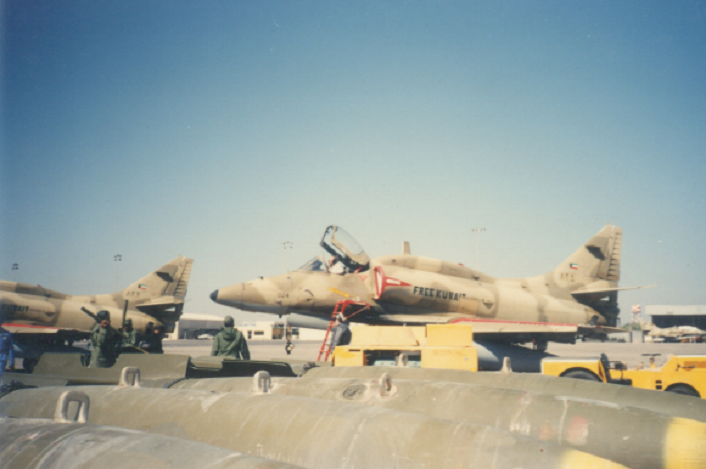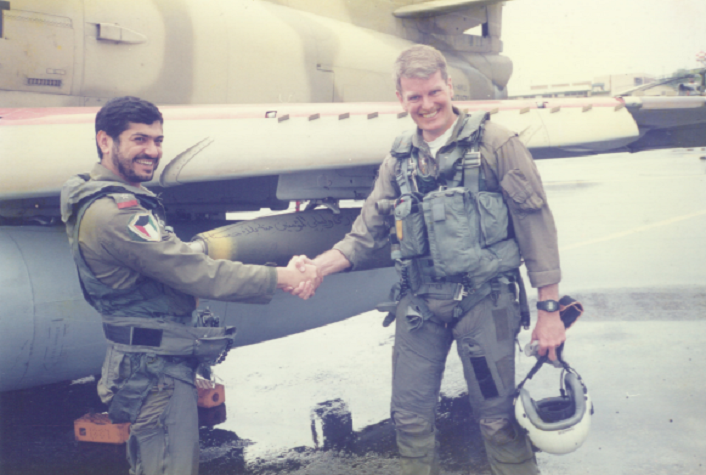“There was a day we returned from an air strike and a Kuwaiti A-4KU pilot was as happy as he could be when he delivered a 500-pound bomb right to the front door of the headquarters office — until he realized that it was his old office,” Commander Robert E. Noziglia, Jr.
The United States and other coalition forces from the United Nations came together on January 17, 1991, to free Kuwait from Iraqi occupation.
Thousands of military personnel were impacted by Operation Desert Storm in terms of their lives and careers. One of these individuals, Commander Robert E. Noziglia, Jr., who was at the time the aircraft maintenance officer at the Naval Air Weapons Station in Point Mugu, California, played a distinctive role in Desert Storm.
On September 15, 1990, Noziglia was interviewed by Ambassador Edward W. Genhm, Jr., the U.S. representative to Kuwait, in Washington, D.C., Cdr. Noziglia was chosen to lead the reconstruction of the Kuwait Air Force, as stated by Vance Vasquez, then staff writer/photographer for The Missile, Naval Air Weapons Station, Point Mugu, California, in the article A Unique Role in Desert Storm that appeared in the July-August 1993 issue of Naval Aviation News. 86 contract technicians and their supplies were flown to Khamis Mushayt, Saudi Arabia, on a Kuwaiti 747 airplane. On September 16, 1990, they left Andrews AFB in Maryland and arrived in Saudi Arabia.

“The technicians were retired Navy and Marine Corps personnel with A-4 Skyhawk experience,” said Noziglia.
Only a small section of the Kuwait Air Force was able to flee into Saudi Arabia when Iraq invaded and overran the little nation. Three L100-30 (C-130) transport planes, 15 Mirage F1 fighters, 18 A-4KUs, and two TA-4KU Skyhawk attack planes were all saved.
No equipment, tools, or aircraft manuals were available to the Kuwait Air Force when they arrived because they had been left behind in Kuwait. “The aircraft was unique. Since no other country operated A-4KU Skyhawks, we were able to assemble new manuals from information obtained from the United States,” said Noziglia.
The A-4KUs were relocated from Khamis Mushayt and were forward deployed to Dhahran, Saudi Arabia after the technicians arrived. Before the United Nations mandate for Iraq to depart Kuwait was ordered, the A-4KUs were stationed far from Iraq to avoid any potential airstrikes. Under a single command, the Royal Saudi Air Force and the Kuwaiti Air Force were combined.
Noziglia credited the Kuwait Air Force with helping to liberate their nation when Operation Desert Storm first began. “There was a day we returned from an airstrike and a Kuwaiti A-4KU pilot was as happy as he could be when he delivered a 500-pound bomb right to the front door of the headquarters office — until he realized that it was his old office,” recalled Noziglia.
“The Kuwaitis had ‘Free Kuwait’ painted on the sides of their A-4KUs, which became the national motto. The A-4KU flew from 18 to 24 sorties per day and only one A-4KU was lost to antiaircraft artillery fire during the war. The pilot became a prisoner of war,” Noziglia stated.
Cdr. Noziglia took part in Operation Desert Recovery after the war. He said that practically all of Kuwait’s military equipment, including the upgraded Hawk surface-to-air missile (SAM) systems, had been transferred back to Iraq by Iraqi forces.

It was thought that Iraqi pilots were shown the A-4KU flying procedures after hundreds of Kuwaiti flight officers were seized, enabling them to fly the A-4KUs left behind back to Iraq. Noziglia said that six of the stolen A-4KUs were flown back to Kuwait after technicians began working on them after discovering them on Iraqi airbases. “The aircraft had been sitting around for months,” he said.
Noziglia stayed in Kuwait to oversee the integration of the F/A-18C/D Hornets that McDonnell Douglas was building for Kuwait. The A-4KU and F-1 were both superseded by the F/A-18C/D. “They’re moving from 1960s-vintage airframes in the A-4KU into the year 2000 with their F/A-18C/D Hornets,” said Noziglia.
“Desert Storm was definitely a highlight of my career. I made a lot of good friends with the Kuwaitis, and we developed a good friendship,” Noziglia emphasized.
As a Kuwait security support officer and Navy liaison officer for his work during Operation Desert Storm, Noziglia was awarded the Joint Service Commendation and was also given a note of appreciation from Ambassador Genhm. The Kuwait Air Force’s Deputy Chief of Staff, Major General Jaber Khaled Al-Sabah, also gave him the Bronze Star Medal and a letter of recognition.

Photo by Robert E. Noziglia

